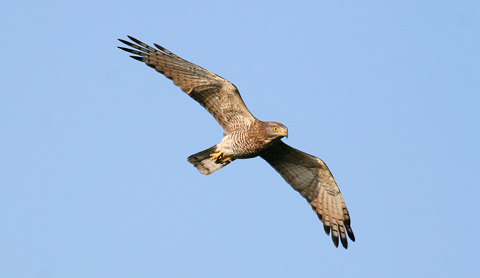The nation has taken a successful step in tracking the migration route of the gray-faced buzzard eagle, or Butastur indicus, paving the way for better conservation measures for the rare migratory bird, a Forestry Bureau official said.
Conservation Division Director Kuan Li-hao (管立豪) said scientists put satellite transmitters on three gray-faced buzzard eagles as they passed through Taiwan this fall. After being released on Oct. 12 in Kenting (墾丁), the birds reached the Philippines the next day.
Kuan said it was the first time that the migratory movements of the species had been recorded anywhere in the world.

PHOTO: CNA
Two of the three birds, nicknamed Cape No. 2 and Cape No. 3, are on Luzon Island, while Cape No. 1 headed further south in the Philippines, Kuan said.
The satellite transmitters on the birds send signals to the research group, which will continue to record the birds’ movements next spring during their migration northward.
Because of budget limitations, the research group could only implant transmitters on three birds.
“But thanks to the research, Taiwan may have the opportunity to cooperate with countries in Southeast Asia, such as the Philippines, to enhance conservation” of this rare species, Kuan said.
The buzzard eagle is listed as protected in the Convention on International Trade in Endangered Species of Wildlife Fauna and Flora.
Normally, 15,000 to 35,000 of the birds pass over Taiwan every year in the spring and autumn, the Forestry Bureau said. This year, however, an estimated 42,000 gray-faced buzzard eagles had crossed over Taiwan by the end of last month — the highest number since the bureau began counting the migration in 1989.
Kuan attributed the higher numbers on the weather, which was relatively stable between Oct. 8 and Oct. 20 compared with previous years.
He said forest district offices had also worked to prevent hunters from killing the birds.

Taiwan is to commence mass production of the Tien Kung (天弓, “Sky Bow”) III, IV and V missiles by the second quarter of this year if the legislature approves the government’s NT$1.25 trillion (US$39.78 billion) special defense budget, an official said yesterday. Commenting on condition of anonymity, a defense official with knowledge of the matter said that the advanced systems are expected to provide crucial capabilities against ballistic and cruise missiles for the proposed “T-Dome,” an advanced, multi-layered air defense network. The Tien Kung III is an air defense missile with a maximum interception altitude of 35km. The Tien Kung IV and V

The disruption of 941 flights in and out of Taiwan due to China’s large-scale military exercises was no accident, but rather the result of a “quasi-blockade” used to simulate creating the air and sea routes needed for an amphibious landing, a military expert said. The disruptions occurred on Tuesday and lasted about 10 hours as China conducted live-fire drills in the Taiwan Strait. The Civil Aviation Administration (CAA) said the exercises affected 857 international flights and 84 domestic flights, affecting more than 100,000 travelers. Su Tzu-yun (蘇紫雲), a research fellow at the government-sponsored Institute for National Defense and Security Research, said the air

Taiwan lacks effective and cost-efficient armaments to intercept rockets, making the planned “T-Dome” interception system necessary, two experts said on Tuesday. The concerns were raised after China’s military fired two waves of rockets during live-fire drills around Taiwan on Tuesday, part of two-day exercises code-named “Justice Mission 2025.” The first wave involved 17 rockets launched at 9am from Pingtan in China’s Fujian Province, according to Lieutenant General Hsieh Jih-sheng (謝日升) of the Office of the Deputy Chief of the General Staff for Intelligence at the Ministry of National Defense. Those rockets landed 70 nautical miles (129.6km) northeast of Keelung without flying over Taiwan,

City buses in Taipei and New Taipei City, as well as the Taipei MRT, would on Saturday begin accepting QR code payments from five electronic payment providers, the Taipei Department of Transportation said yesterday. The new option would allow passengers to use the “transportation QR code” feature from EasyWallet, iPass Money, iCash Pay, Jkopay or PXPay Plus. Passengers should open their preferred electronic payment app, select the “transportation code” — not the regular payment code — unlock it, and scan the code at ticket readers or gates, General Planning Division Director-General Liu Kuo-chu (劉國著) said. People should move through the